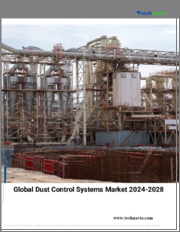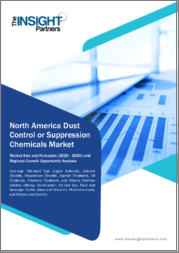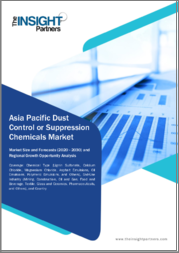
|
시장보고서
상품코드
1622876
세계의 방진 시장 : 산업 분석, 규모, 점유율, 성장, 동향 및 예측(2024-2034)Dust Control Market: Global Industry Analysis, Size, Share, Growth, Trends, and Forecast, 2024-2034 |
||||||
세계 방진 시장 규모는 2024년 174억 1,190만 달러에 이르고, 2024-2034년의 예측 기간 동안 4.30%의 연평균 복합 성장률(CAGR)로 확대되어 2034년에는 266억 2,890만 달러에 달할 것으로 예상됩니다.
방진 시장에는 광업, 건설, 제조, 운송 등 다양한 산업에서 먼지를 줄이고 제어하기 위한 다양한 제품과 기술이 포함됩니다. 이러한 제품에는 수성 먼지 억제제, 폴리머 기반 솔루션, 정전기 먼지 억제 시스템 등이 포함됩니다. 이 시장은 환경 규정 준수, 산업 보건 및 작업 효율을 우선시하는 산업을 대상으로 합니다. 엄격한 정부 규제, 환경 위생에 대한 인식 증가, 첨단 방진 기술 채택이 성장의 원동력이 되고 있습니다.
여러 가지 요인이 세계 방진 시장을 주도하고 있습니다. 특히 개발도상국에서의 산업 활동 증가는 환경 기준을 충족하기 위한 효과적인 방진 솔루션에 대한 수요를 촉진하고 있습니다. 또한, 공기질 모니터링을 위한 IoT 지원 센서의 통합과 같은 먼지 억제 및 수집 시스템의 기술 발전도 시장 확대의 원동력이 되고 있습니다. 또한, 작업자 안전에 대한 관심 증가와 분진 배출로 인한 환경적 영향을 줄여야 한다는 필요성도 방진 대책의 채택을 촉진하고 있습니다. 환경 친화적이고 생분해성 분진 억제제의 개발은 시장 확대에 더욱 기여하고 있습니다.
방진 시장은 지속 가능한 관행의 채택 증가와 신흥 경제권에서 고급 솔루션에 대한 수요가 증가함에 따라 큰 기회를 맞이하고 있습니다. 실시간 모니터링 기능을 갖춘 자동 방진 시스템의 개발은 효율성과 규정 준수를 요구하는 산업계에 대응하고 있습니다. 아시아태평양 및 아프리카 등의 지역에서는 도시화 및 인프라 개발이 확대되고 있어 시장 성장의 새로운 길을 열어주고 있습니다. 이러한 기회를 활용하기 위해서는 전략적 제휴, R&D 투자, 맞춤형 솔루션 도입이 필수적입니다.
이 보고서는 세계 방진 시장을 조사했으며, 제품 유형별, 용도별, 지역별 동향, 시장 진출기업 프로파일 등의 정보를 제공합니다.
목차
제1장 주요 요약
제2장 시장 서론
제3장 세계의 방진 시장 시나리오
- 가격 분석
- 시장 규모(100만 달러)와 예측
- 시장 개요
제4장 시장 역학
제5장 세계의 방진 시장 분석과 예측(제품 유형별)
제6장 세계의 방진 시장 분석과 예측(용도별)
제7장 세계의 방진 시장 분석과 예측(지역별)
제8장 북미의 방진 시장 분석과 예측
제9장 라틴아메리카의 방진 시장 분석과 예측
제10장 서유럽의 방진 시장 분석과 예측
제11장 동유럽의 방진 시장 분석과 예측
제12장 아시아태평양(일본 제외)의 방진 시장 분석과 예측
제13장 일본의 방진 시장 분석과 예측
제14장 중동 및 아프리카의 방진 시장 분석과 예측
제15장 경쟁 구도
- 경쟁 대시보드
- 기업 분석
- 기업 개요(상세 - 개요, 재무, 전략, 최근 동향)
- 세계의 참여 기업
- Global Road Technology
- Quaker Chemical Corporation
- Donaldson Company, Inc.
- Nederman Holding AB
- Camfil
- JKF Industri A/S
- Sly Environmental Technology Ltd
- Beltran Technologies, Inc.
제16장 사용된 전제조건과 두자어
제17장 조사 방법
LSH 25.01.10Persistence Market Research has recently published an extensive report on the global Dust Control Market. This report offers a comprehensive analysis of the key market dynamics, including drivers, trends, opportunities, and challenges, providing deep insights into the market structure.
Key Insights:
- Dust Control Market Size (2024E): USD 17411.9 Mn
- Projected Market Value (2034F): USD 26628.9 Mn
- Global Market Growth Rate (CAGR 2024 to 2034): 4.30%
Dust Control Market - Report Scope:
The Dust Control Market encompasses a variety of products and technologies aimed at mitigating and controlling dust in diverse industries such as mining, construction, manufacturing, and transportation. These products include water-based dust suppressants, polymer-based solutions, and electrostatic dust control systems. The market caters to industries that prioritize environmental compliance, occupational health, and operational efficiency. Growth is driven by stringent government regulations, increasing awareness of environmental health, and the adoption of advanced dust control technologies.
Market Growth Drivers:
Several key factors are driving the global Dust Control Market. Increasing industrial activities, particularly in developing regions, are fueling the demand for effective dust control solutions to meet environmental standards. Technological advancements in dust suppression and collection systems, such as the integration of IoT-enabled sensors for monitoring air quality, are also driving market expansion. Additionally, the rising focus on worker safety and the need to reduce the environmental impact of dust emissions have spurred the adoption of dust control measures. The development of eco-friendly and biodegradable dust suppressants further contributes to market growth.
Market Restraints:
Despite promising growth prospects, the Dust Control Market faces challenges related to high initial costs and maintenance requirements for advanced dust control systems. Small and medium-sized enterprises (SMEs) may find it difficult to invest in expensive technologies, which could hinder market penetration. Additionally, fluctuations in raw material prices for dust suppressants and the lack of awareness in certain regions can limit market growth. Addressing these issues requires affordable and scalable solutions tailored to the needs of different industries and regions.
Market Opportunities:
The Dust Control Market presents significant opportunities driven by the increasing adoption of sustainable practices and the growing demand for advanced solutions in emerging economies. The development of automated dust control systems with real-time monitoring capabilities caters to industries looking for efficiency and compliance. Expanding urbanization and infrastructure development in regions such as Asia-Pacific and Africa create new avenues for market growth. Strategic collaborations, investments in research and development, and the introduction of customizable solutions are essential for capitalizing on these opportunities.
Key Questions Answered in the Report:
- What are the primary factors driving the growth of the Dust Control Market globally?
- Which types of dust control products and systems are leading the adoption in various industries?
- How are technological advancements influencing the competitive landscape of the Dust Control Market?
- Who are the key players in the Dust Control Market, and what strategies are they employing to stay competitive?
- What are the emerging trends and future prospects in the global Dust Control Market?
Competitive Intelligence and Business Strategy:
Leading players in the global Dust Control Market, including Donaldson Company, Inc., Camfil, and Nederman Holding AB, focus on innovation, product differentiation, and strategic collaborations to gain a competitive edge. These companies invest in R&D to develop advanced dust control solutions and explore emerging technologies such as electrostatic precipitation. Collaborations with industrial clients, distributors, and government bodies facilitate market access and promote the adoption of innovative products. Emphasis on environmental compliance, high-quality solutions, and comprehensive customer support fosters market growth and enhances brand loyalty in the evolving Dust Control Market landscape.
Key Companies Profiled:
- Global Road Technology
- Quaker Chemical Corporation
- Donaldson Company, Inc.
- Nederman Holding AB
- Camfil
- JKF Industri A/S
- Sly Environmental Technology Ltd
- Beltran Technologies, Inc.
- Other
Dust Control Market Industry Segmentation:
By Product Type:
- Wet Suppression
- Dry Collection
- Electrostatic Dust Control
- Foam-Based Dust Control
By End Use Industry:
- Mining
- Construction
- Manufacturing
- Oil & Gas
- Transportation & Logistics
By Application:
- Roadways
- Stockpiles
- Material Handling
- Others
By Region:
- North America
- Latin America
- Europe
- South Asia & Pacific
- East Asia
- Middle East & Africa
Table of Contents
1. Executive Summary
2. Market Introduction
- 2.1. Market Taxonomy
3. Global Dust Control Market Scenario
- 3.1. Pricing Analysis
- 3.2. Market Size (US$ Mn ) and Forecast
- 3.2.1. Market Size and Y-o-Y Growth
- 3.2.2. Absolute $ Opportunity
- 3.3. Market Overview
- 3.3.1. Value Chain
- 3.3.2. Profit Margin Analysis
- 3.3.3. List of Component manufacturers and Key Players
4. Market Dynamics
- 4.1. Drivers
- 4.2. Restraints
- 4.3. Forecast Factors - Relevance and Impact
5. Global Dust Control Market Analysis and Forecast, By Product Type
- 5.1. Introduction
- 5.1.1. Basis Point Share (BPS) Analysis By Product Type
- 5.1.2. Y-o-Y Growth Projections By Product Type
- 5.2. Market Size (US$ Mn ) and Volume ('000) Forecast By Product Type
- 5.2.1. Dry Type Dust Control System
- 5.2.1.1. Bag Dust Filter
- 5.2.1.2. Cyclone Dust Filter
- 5.2.1.3. Electrostatic Dust Filter
- 5.2.1.4. Vacuum Dust Filter
- 5.2.1.5. Modular Filter
- 5.2.2 Wet Type Dust Control System
- 5.2.2.1. Wet Scrubbers
- 5.2.2.2. Wet Suppressant
- 5.2.2.3. Wet Electrostatic Precipitator (WEPS)
- 5.2.1. Dry Type Dust Control System
- 5.3. Market Attractiveness Analysis By Product Type
- 5.4. Prominent Trends
6. Global Dust Control Market Analysis and Forecast, By Application
- 6.1. Introduction
- 6.1.1. Basis Point Share (BPS) Analysis By Application
- 6.1.2. Y-o-Y Growth Projections By Application
- 6.2. Market Size (US$ Mn ) and Volume ('000) Forecast By Application
- 6.2.1. Mining
- 6.2.2. Construction
- 6.2.3. Power & Utilities
- 6.2.4. Chemical & Processing
- 6.2.5. Oil & Gas
- 6.2.6. Pharmaceuticals
- 6.2.7. Others
- 6.3. Market Attractiveness Analysis By Application
7. Global Dust Control Market Analysis and Forecast, By Region
- 7.1. Introduction
- 7.1.1. Basis Point Share (BPS) Analysis By Region
- 7.1.2. Y-o-Y Growth Projections By Region
- 7.2. Market Size (US$ Mn ) and Volume ('000) Forecast By Region
- 7.2.1. North America
- 7.2.2. Latin America
- 7.2.3. Eastern Europe
- 7.2.4. Western Europe
- 7.2.5. APEJ
- 7.2.6. Japan
- 7.2.7. MEA
- 7.3. Market Attractiveness Analysis By Region
8. North America Dust Control Market Analysis and Forecast
- 8.1. Introduction
- 8.1.1. Basis Point Share (BPS) Analysis By Country
- 8.1.2. Y-o-Y Growth Projections By Country
- 8.2. Market Size (US$ Mn ) and Volume ('000) Forecast By Country
- 8.2.1. US
- 8.2.2. Canada
- 8.3. Market Size (US$ Mn ) and Volume ('000) Forecast By Product Type
- 8.3.1. Dry Type Dust Control System
- 8.3.2. Wet Type Dust Control System
- 8.4. Market Size (US$ Mn ) and Volume ('000) Forecast By Application
- 8.4.1. Mining
- 8.4.2. Construction
- 8.4.3. Power & Utilities
- 8.4.4. Chemical & Processing
- 8.4.5. Oil & Gas
- 8.4.6. Pharmaceuticals
- 8.4.7. Others
- 8.5. Market Attractiveness Analysis
- 8.5.1. By Country
- 8.5.2. By Product Type
- 8.5.3. By Application
- 8.6. Prominent Trends
9. Latin America Dust Control Market Analysis and Forecast
- 9.1. Introduction
- 9.1.1. Basis Point Share (BPS) Analysis By Country
- 9.1.2. Y-o-Y Growth Projections By Country
- 9.2. Market Size (US$ Mn ) and Volume ('000) Forecast By Country
- 9.2.1. Mexico
- 9.2.2. Brazil
- 9.2.3. Rest of Latin America
- 9.3. Market Size (US$ Mn ) and Volume ('000) Forecast By Product Type
- 9.3.1. Dry Product Type
- 9.3.2. Wet Product Type
- 9.4. Market Size (US$ Mn ) and Volume ('000) Forecast By Application
- 9.4.1. Mining
- 9.4.2. Construction
- 9.4.3. Power & Utilities
- 9.4.4. Chemical & Processing
- 9.4.5. Oil & Gas
- 9.4.6. Pharmaceutical
- 9.4.7. Others
- 9.5. Market Attractiveness Analysis
- 9.5.1. By Country
- 9.5.2. By Product Type
- 9.5.3. By Application
- 9.6. Prominent Trends
10. Western Europe Dust Control Market Analysis and Forecast
- 10.1. Introduction
- 10.1.1. Basis Point Share (BPS) Analysis By Country
- 10.1.2. Y-o-Y Growth Projections By Country
- 10.2. Market Size (US$ Mn ) and Volume ('000) Forecast By Country
- 10.2.1. Germany
- 10.2.2. France
- 10.2.3. Italy
- 10.2.4. Spain
- 10.2.5. UK
- 10.2.6. Benelux
- 10.2.7. Rest of Western Europe
- 10.3. Market Size (US$ Mn ) and Volume ('000) Forecast By Product Type
- 10.3.1. Dry Type Dust Control System
- 10.3.2. Wet Type Dust Control System
- 10.4. Market Size (US$ Mn ) and Volume ('000) Forecast By Application
- 10.4.1. Mining
- 10.4.2. Construction
- 10.4.3. Power & Utilities
- 10.4.4. Chemical & Processing
- 10.4.5. Oil & Gas
- 10.4.6. Pharmaceuticals
- 10.4.7. Others
- 10.5. Market Attractiveness Analysis
- 10.5.1. By Country
- 10.5.2. By Product Type
- 10.5.3. By Application
- 10.6. Prominent Trends
11. Eastern Europe Dust Control Market Analysis and Forecast
- 11.1. Introduction
- 11.1.1. Basis Point Share (BPS) Analysis By Country
- 11.1.2. Y-o-Y Growth Projections By Country
- 11.2. Market Size (US$ Mn ) and Volume ('000) Forecast By Country
- 11.2.1. Poland
- 11.2.2. Russia
- 11.2.3. Rest of Eastern Europe
- 11.3. Market Size (US$ Mn ) and Volume ('000) Forecast By Product Type
- 11.3.1. Dry Type Dust Control System
- 11.3.2. Wet Type Dust Control System
- 11.4. Market Size (US$ Mn ) and Volume ('000) Forecast By Application
- 11.4.1. Mining
- 11.4.2. Construction
- 11.4.3. Power & Utilities
- 11.4.4. Chemical & Processing
- 11.4.5. Oil & Gas
- 11.4.6. Pharmaceuticals
- 11.4.7. Others
- 11.5. Market Attractiveness Analysis
- 11.5.1. By Country
- 11.5.2. By Product Type
- 11.5.3. By Application
- 11.6. Prominent Trends
12. Asia Pacific except Japan (APEJ) Dust Control Market Analysis and Forecast
- 12.1. Introduction
- 12.1.1. Basis Point Share (BPS) Analysis By Country
- 12.1.2. Y-o-Y Growth Projections By Country
- 12.2. Market Size (US$ Mn ) and Volume ('000) Forecast By Country
- 12.2.1. China
- 12.2.2. India
- 12.2.3. Korea Republic
- 12.2.4. ASEAN
- 12.2.5. Australia & New Zealand
- 12.2.6. Rest of APEJ
- 12.3. Market Size (US$ Mn ) and Volume ('000) Forecast By Product Type
- 12.3.1. Dry Product Type
- 12.3.2. Wet Product Type
- 12.4. Market Size (US$ Mn ) and Volume ('000) Forecast By Application
- 12.4.1. Mining
- 12.4.2. Construction
- 12.4.3. Power & Utilities
- 12.4.4. Chemical & Processing
- 12.4.5. Oil & Gas
- 12.4.6. Pharmaceuticals
- 12.4.7. Others
- 12.5. Market Attractiveness Analysis
- 12.5.1. By Country
- 12.5.2. By Product Type
- 12.5.3. By Application
- 12.6. Prominent Trends
13. Japan Dust Control Market Analysis and Forecast
- 13.1. Market Size (US$ Mn ) and Volume ('000) Forecast By Product Type
- 13.1.1. Dry Product Type
- 13.1.2. Wet Product Type
- 13.2. Market Size (US$ Mn ) and Volume ('000) Forecast By Application
- 13.2.1. Mining
- 13.2.2. Construction
- 13.2.3. Power & Utilities
- 13.2.4. Chemical & Processing
- 13.2.5. Oil & Gas
- 13.2.6. Pharmaceuticals
- 13.2.7. Others
- 13.3. Market Attractiveness Analysis
- 13.3.1. By Product Type
- 13.3.2. By Application
- 13.4. Prominent Trends
14. Middle East Africa (MEA) Dust Control Market Analysis and Forecast
- 14.1. Introduction
- 14.1.1. Basis Point Share (BPS) Analysis By Country
- 14.1.2. Y-o-Y Growth Projections By Country
- 14.2. Market Size (US$ Mn ) and Volume ('000) Forecast By Country
- 14.2.1. GCC
- 14.2.2. South Africa
- 14.2.3. Israel
- 14.2.4. Rest of MEA
- 14.3. Market Size (US$ Mn ) and Volume ('000) Forecast By Product Type
- 14.3.1. Dry Product Type
- 14.3.2. Wet Product Type
- 14.4. Market Size (US$ Mn ) and Volume ('000) Forecast By Application
- 14.4.1. Mining
- 14.4.2. Construction
- 14.4.3. Power & Utilities
- 14.4.4. Chemical & Processing
- 14.4.5. Oil & Gas
- 14.4.6. Pharmaceuticals
- 14.4.7. Others
- 14.5. Market Attractiveness Analysis
- 14.5.1. By Country
- 14.5.2. By Product Type
- 14.5.3. By Application
- 14.6. Prominent Trends
15. Competition Landscape
- 15.1. Competition Dashboard
- 15.2. Company Analysis
- 15.3. Company Profiles (Details - Overview, Financials, Strategy, Recent Developments)
- 15.4. Global Players
- 15.4.1. Global Road Technology
- 15.4.2. Quaker Chemical Corporation
- 15.4.3. Donaldson Company, Inc.
- 15.4.4. Nederman Holding AB
- 15.4.5. Camfil
- 15.4.6. JKF Industri A/S
- 15.4.7. Sly Environmental Technology Ltd
- 15.4.8. Beltran Technologies, Inc.



















